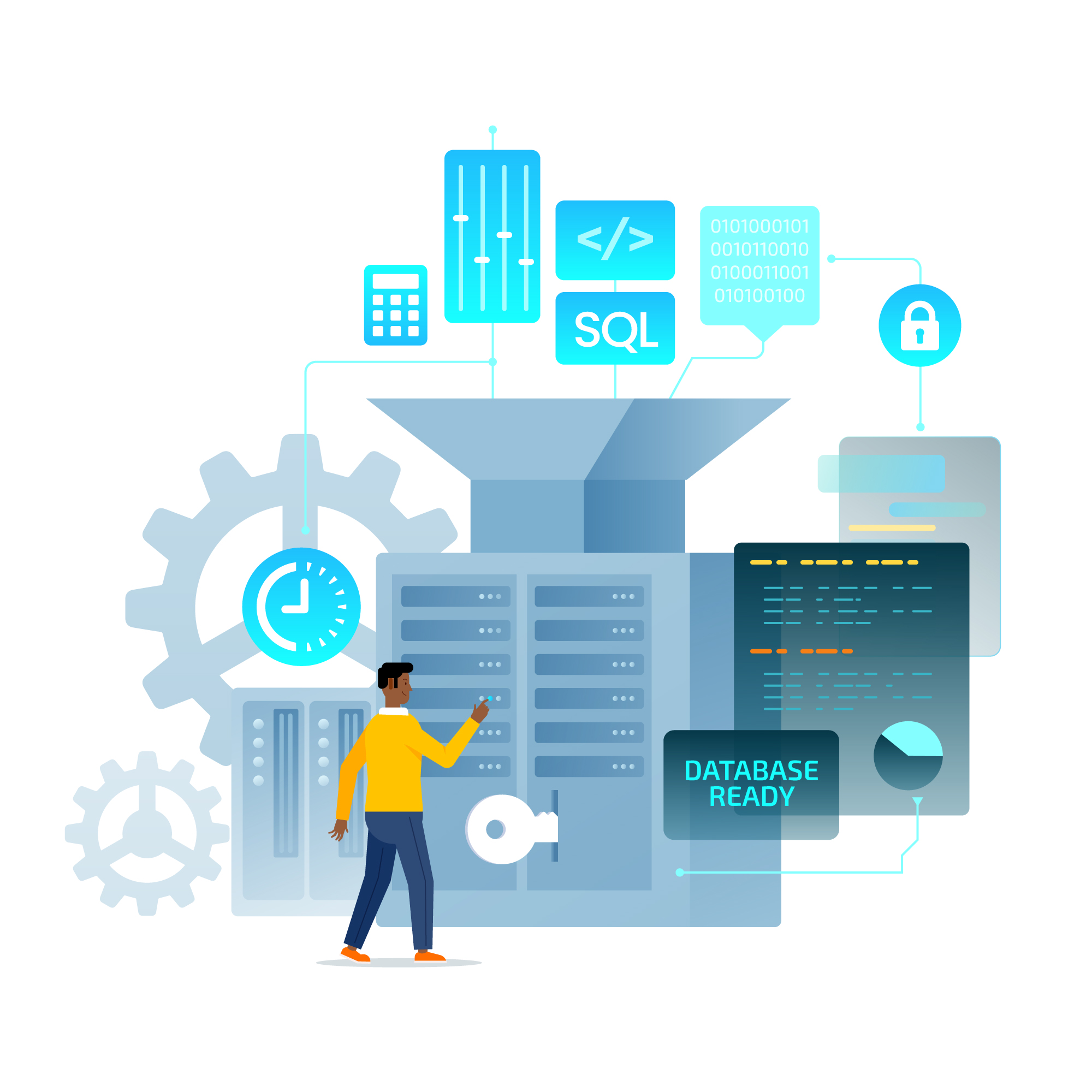Terraform and AWS CloudFormation are popular Infrastructure as Code (IaC) services that allow businesses to manage their infrastructure resources in a programmatic and automated way. Both have unique strengths and weaknesses, but it is crucial to consider your business needs and priorities when it comes down to choosing between them. In this blog, we will discuss the various aspects of Terraform vs. CloudFormation in detail.
Terraform
Terraform is an open-source tool that enables businesses to implement infrastructure as code (IaC) services. Terraform modules help organizations automate the creation, modification, and versioning of infrastructure resources in a consistent and repeatable manner. It supports multiple cloud providers, as well as on-premise data centers. Hence, it is a versatile tool for businesses of any size.
With Terraform, organizations can manage their entire infrastructure through code, allowing them to track changes, detect drift, and revert to previous configurations if required. As a result, it significantly reduces manual errors of Terraform developers and increases efficiency, making it an ideal choice for businesses looking to streamline their infrastructure management process.
AWS CloudFormation
AWS CloudFormation is an Infrastructure as Code (IaC) service offered by Amazon Web Services (AWS). CloudFormation uses templates written in JSON or YAML to define and deploy infrastructure as code (IaC). Hence businesses can define their infrastructure in a version-controlled, repeatable manner, making it easier to automate the deployment processes.
CloudFormation also provides tools to manage changes to the infrastructure, roll back when necessary, and monitor the health and status of AWS resources. With CloudFormation, businesses can simplify and speed up the process of setting up and managing their infrastructure on AWS, allowing them to focus on their core application development.
AWS Cloud Development Kit (CDK)
AWS Cloud Development Kit (CDK) is a software development framework for defining cloud infrastructure as code and provisioning it through AWS CloudFormation. CDK allows developers to use familiar programming languages such as TypeScript, Python, Java, and C# to define cloud resources and deploy them through AWS services. With CDK, developers can use AWS services to create reusable cloud components. As a result, it will help to automate infrastructure provisioning and increase development speed and efficiency. In addition, CDK supports multiple deployment models, including AWS CloudFormation, AWS Serverless Application Model (SAM), and others, making it an ideal tool for businesses looking to develop and manage their cloud infrastructure in a flexible, scalable, and efficient manner.
Automating Infrastructure-as-Code
Automating Infrastructure-as-Code (IaC) is a game-changer for businesses looking for a proficient and cost-effective way to manage their IT infrastructure. IaC stores all configurations in version control and can be easily versioned, audited, and tested. The result is a much more streamlined and consistent deployment process. Ultimately it will reduce the risk of human error and enable businesses to roll out changes quickly and easily.
This automation helps businesses quickly deploy resources and new applications, configure servers, and manage network configurations in an efficient and consistent manner. Additionally, IaC can provide businesses with greater transparency and control over their infrastructure, making diagnosing and resolving issues promptly easier.
What Is the Primary Difference Between Terraform and AWS CloudFormation?
Both, Terraform and CloudFormation are the two most popular cloud infrastructure as code (IAC) tools. But they differ in their scope and functionality. Terraform is a multi-cloud platform that enables users to define and provision infrastructure across different cloud providers. On the other hand, CloudFormation is a solution specifically designed for Amazon Web Services. It is used to manage AWS infrastructure.
Key Differences Between Terraform vs. AWS CloudFormation
Let’s delve into a comprehensive comparison of Terraform vs. AWS CloudFormation.
Resource providers
Terraform offers a diverse range of cloud providers, including third-party resources, which gives businesses more flexibility in their infrastructure management. As a result, businesses can access a wider range of resources and services managed by Terraform, including those not offered by AWS. Whereas, CloudFormation is limited to AWS resources and services.
Code Syntax
One of the critical differences between Terraform and CloudFormation is the code syntax they use. Terraform uses HashiCorp Configuration Language (HCL). It is a human-friendly language that is easy to read and write. On the other hand, CloudFormation uses JSON or YAML, which is a more complex syntax to understand.
Hence, Terraform’s code syntax is more user-friendly, making it a better option for businesses looking for an IaC service that is easy to use and requires less technical expertise.
Rollbacks
Rollbacks refer to the ability to undo any changes made to the cloud infrastructure in the event of failure. Terraform and CloudFormation both offer rollback capabilities. However, Terraform offers a more seamless experience. In Terraform, rollbacks can be initiated automatically in case of an error. The entire process can be done in a few minutes, requiring little to no manual intervention. In contrast, AWS CloudFormation requires manual intervention and can take longer to complete a rollback.
As a result, Terraform’s rollback functionality can save businesses valuable time in the long run. Also, they can access custom resources, making it a more appealing choice for those looking for a comprehensive IaC solution.
State Management
State management refers to how the IaC service keeps track of the current state of your entire infrastructure and how it changes over time. In Terraform, the state is stored locally by default and can also be stored remotely for collaboration purposes.
On the other hand, CloudFormation manages the state of AWS infrastructure internally and does not provide a mechanism for users to interact with the state directly. As a result, it will lead to difficulties in tracking changes and maintaining consistency.
Hence, Terraform’s state management system offers a more centralized and efficient way to manage infrastructure, making it a more suitable option for businesses looking for a streamlined IaC service.
Multi-Cloud Integration
Terraform is cloud agnostic and supports multi-cloud integration, meaning businesses can manage their infrastructure on multiple cloud platforms using a single tool. This feature makes Terraform a more flexible and scalable solution compared to CloudFormation, which is limited to AWS services.
With Terraform, businesses can leverage the best of multiple cloud providers, maximizing their resources and minimizing vendor lock-in. This integration also helps businesses achieve a seamless and streamlined process for managing their infrastructure.
Enterprise Support
It is a critical factor when choosing between Terraform and CloudFormation as your IaC service. While both services offer basic support, Terraform offers a more comprehensive enterprise support package that includes 24/7 support, a dedicated account management team, and access to advanced technical resources.
CloudFormation’s enterprise support is limited and does not provide the same level of hands-on support and technical expertise. But if your organization utilizes AWS Enterprise Support, AWS can help you directly when you encounter any problem managing AWS resources.
The Final Battle: Advantages and disadvantages of Terraform vs. CloudFormation
When it comes to automating infrastructure, there are two main options for businesses looking for infrastructure as code (IaC) services: Terraform and CloudFormation. Both have their own pros and cons, and the choice between them ultimately depends on the specific needs of your business.
Terraform is an open-source IaC service that supports many cloud providers, including AWS, Google Cloud Platform, and Microsoft Azure. One of the biggest advantages of Terraform is its flexibility. It allows businesses to manage their infrastructure across multiple cloud providers in a single place. Also, Terraform provides an easy-to-use syntax, making it easier to automate complex infrastructure deployments.
On the other hand, CloudFormation is an AWS-specific IaC service that allows businesses to automate their infrastructure deployment and management within the AWS environment. One of the biggest advantages of CloudFormation is its close integration with other AWS services. CloudFormation also provides a more streamlined deployment process, as it integrates with AWS tools like the AWS Management Console and AWS CLI.
Regarding disadvantages, Terraform can be more difficult to use for AWS-specific deployments, as it requires a deeper understanding of AWS services. CloudFormation, on the other hand, may not be as flexible as Terraform, as it is limited to the AWS environment. Additionally, Terraform may have a steeper learning curve for businesses that are new to IaC.
Conclusion
Terraform and AWS CloudFormation are both powerful and reliable Infrastructures as Code (IaC) services. However, Terraform offers more flexibility, scalability, and support for multiple cloud platforms. Meanwhile, AWS CloudFormation provides better integration with the AWS ecosystem but with less room for customization.
When choosing between Terraform vs. AWS CloudFormation, it is crucial to consider the specific needs and goals of your business. Both services have their own strengths and limitations. Hence, we recommend to take time to evaluate them before making a decision. Ultimately, the right IaC service will allow you to automate infrastructure deployment, streamline management, and reduce the risk of human error.
FAQ’s
How To Use CloudFormation Templates?
To use CloudFormation templates, you must create a JSON or YAML template describing your desired infrastructure configuration. Then use the CloudFormation service to create and deploy the infrastructure stack. This process is quick and simple. In addition, you can easily manage AWS resources by using CloudFormation templates. Also, they can help to reduce operational overhead, automate processes and ensure consistency across all your infrastructure deployments.
Why Choose Terraform Over CloudFormation?
When comparing Terraform vs. AWS CloudFormation, both tools can automate infrastructure deployment, manage configuration changes, and control version. However, there are certain reasons why businesses may choose Terraform over CloudFormation.
- Multi-cloud support: Terraform is cloud agnostic and can manage resources across multiple cloud providers.
- Open-source technology: It is an open-source tool allowing a more flexible and customizable solution.
- Simplified syntax: Terraform uses simpler syntax, making it easier to understand and implement.
- Automated deployment: It offers automated deployment, reducing the manual effort involved in managing infrastructure.
- Better documentation and community support: Terraform has a comprehensive documentation library and a large community of users who can provide support and guidance.




